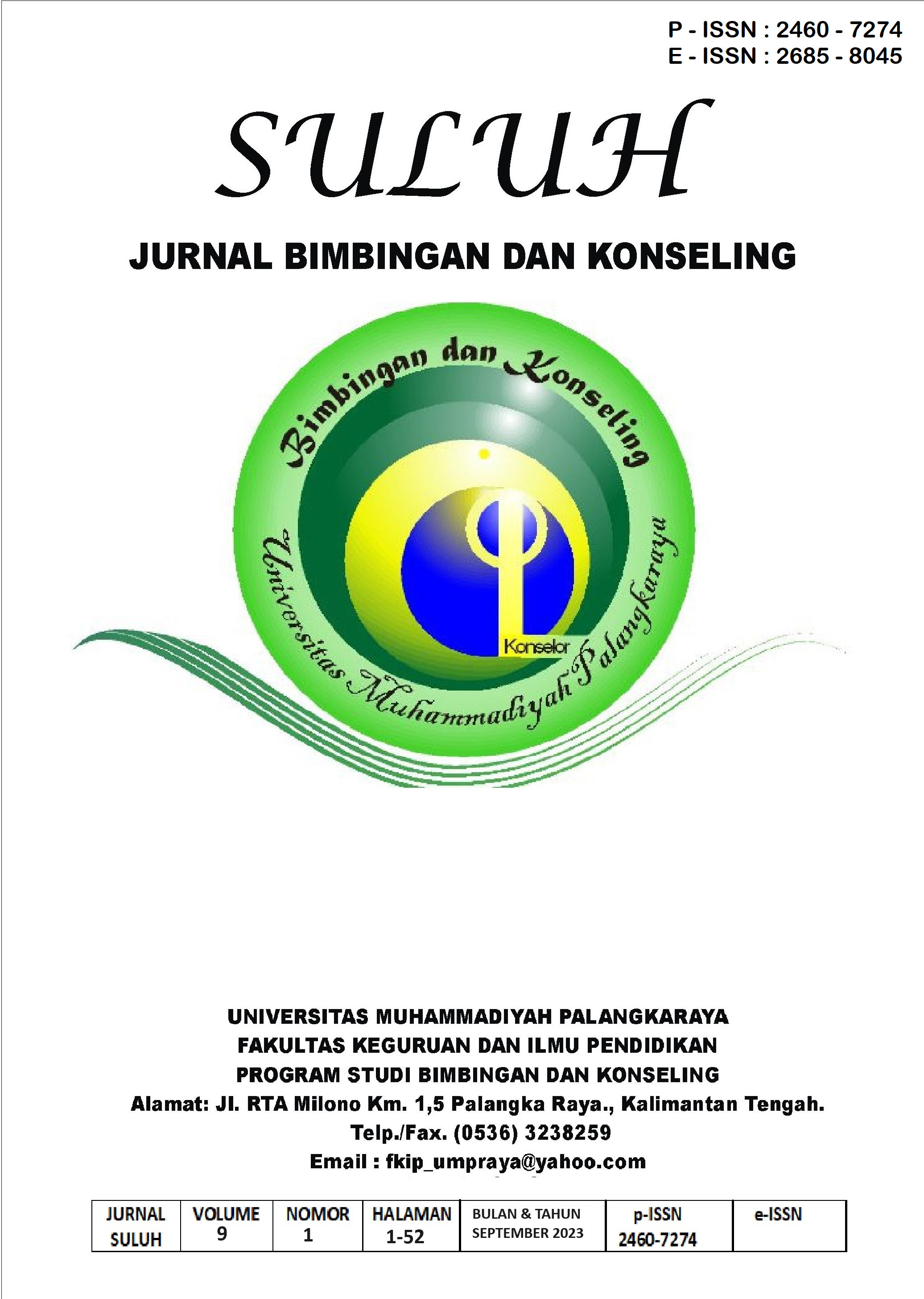Relationship of Internal Locus Of Control To Career Maturity Through Self-Efficacy
Main Article Content
Abstract
This research aims to determine the relationship between internal locus of control and career maturity through student self-efficacy. The sample used was active students at Semarang State University 2017. The sampling technique in this research used a random sampling technique with degrees of error using the Isaac Michael table guide. The data analysis technique used is the template/model 4 mediation statistical analysis technique developed by Hayes. The research results show that internal locus of control through self-efficacy does not significantly affect the career maturity of students at the Faculty of Education, Semarang State University. The internal locus of the control variable, which has no significant effect on self-efficacy, can be explained by (β = 0.0937; t(321) = 0.5160; and p > 0.05).
Downloads
Article Details

This work is licensed under a Creative Commons Attribution-ShareAlike 4.0 International License.
All rights reserved. This publication may be reproduced, stored in a retrieval system, or transmitted in any form or by any means, electronic, mechanical, photocopying, recording.
References
Aji, R., & Rusmawati, D. D. (2010). HUBUNGAN ANTARA LOCUS OF CONTROL INTERNAL DENGAN KEMATANGAN KARIR PADA SISWA KELAS XII SMK N 4 PURWOREJO.
Ana, A., & Wibowo, M. E. (2017). Bimbingan Kelompok dengan Teknik Role Playing untuk Meningkatkan Self-Efficacy dan Harapan Hasil (Outcome Expectations) Karir Siswa.
Ardiyanti, D., & Alsa, A. (n.d.). Pelatihan “PLANS” untuk Meningkatkan Efikasi Diri dalam Pengambilan Keputusan Karir.
Bandura, A., Freeman, W. H., & Lightsey, R. (1999). Self-Efficacy: The Exercise of Control. Journal of Cognitive Psychotherapy, 13(2), 158–166. https://doi.org/10.1891/0889-8391.13.2.158
Blustein, D. L. (1989). The role of goal instability and career self-efficacy in the career exploration process. Journal of Vocational Behavior, 35(2), 194–203. https://doi.org/10.1016/0001-8791(89)90040-7
Brown, S. D., & Lent, R. W. (Eds.). (2013). Career development and counseling: Putting theory and research to work (2nd ed) [Electronic resource]. Wiley.
Busacca, L. A., & Taber, B. J. (2002). The Career Maturity Inventory-Revised: A Preliminary Psychometric Investigation. Journal of Career Assessment, 10(4), 441–455. https://doi.org/10.1177/1069072702238406
Corsini, R. J., & Marsella, A. J. (1983). Personality theories, research & assessment. F.E. Peacock Publishers.
Creswell, J. W. (2014). Research design: Qualitative, quantitative, and mixed methods approaches (4th ed). SAGE Publications.
Fatchurahman, M., Setiawan, M. A., & Karyanti, K. (2023). Intervention group logotherapy and performance measures for reducing phubbing in Generation Z. Estudos de Psicologia (Campinas), 40, e200244.
Friedman, H. S., & Schustack, M. W. (2012). Personality: Classic theories and modern research (5th ed). Pearson Allyn & Bacon.
Gladding, S. T. (2009). Counseling: A comprehensive profession (6th ed). Merrill/Pearson.
Hartiningtyas, L., & Elmunsyah, H. (2016). HUBUNGAN ANTARA SELF REGULATED LEARNING DAN LOCUS OF CONTROL INTERNAL DENGAN KEMATANGAN VOKASIONAL SISWA SMK.
Hayes, A. F., & Preacher, K. J. (2014). Statistical mediation analysis with a multicategorical independent variable. British Journal of Mathematical and Statistical Psychology, 67(3), 451–470. https://doi.org/10.1111/bmsp.12028
Herr, E. L., Cramer, S. H., & Niles, S. G. (2004). Career guidance and counseling through the lifespan: Systematic approaches (6th ed). Pearson/Allyn and Bacon.
Imbimbo, P. V. (1994). Integrating Personal and Career Counseling: A Challenge for Counselors. Journal of Employment Counseling, 31(2), 50–59. https://doi.org/10.1002/j.2161-1920.1994.tb00414.x
Khasanah, E., Purwanto, E., & Tadjri, I. (2017). Pengembangan Model Bimbingan Kelompok Berbasis Life Skills dalam Pengambilan Keputusan Karir.
Kimchick, M. (1997). The relationship between career maturity and locus of control in college students.
Krefting, L. A., Brown, D., & Brooks, L. (1986). Career Choice Development: Applying Contemporary Theories to Practice. Administrative Science Quarterly, 31(3), 471. https://doi.org/10.2307/2392835
Lee, S.-A., Lee, H.-S., Song, H.-S., & Kim, S.-G. (2015). The relationship between attachment and career maturity: The mediating role of self-efficacy. International Social Work, 58(1), 153–164. https://doi.org/10.1177/0020872812456053
Lefcourt, H. M. (Ed.). (2014). Locus of Control (0 ed.). Psychology Press. https://doi.org/10.4324/9781315798813
Lundberg_uncg_9618161.PDF. (n.d.).
Marjohan, M. (2013). Pengembangan Internal Locus of Control dalam Pelayanan Konseling dan Implikasinya terhadap Perbedaan Budaya Klien. Jurnal Konseling Dan Pendidikan, 1(2), 136–142. https://doi.org/10.29210/12100
Marpaung, D. N., & Yulandari, N. (2017). KEMATANGAN KARIR SISWA SMU BANDA ACEH DITINJAU DARI JENIS KELAMIN DAN JENIS SEKOLAH. Psikoislamedia : Jurnal Psikologi, 1(2). https://doi.org/10.22373/psikoislamedia.v1i2.918
Migunde, Q., Othuon, L., & Mbagaya, C. (2016). ADOLESCENTS SELF ESTEEM AND ITS EFFECT ON CAREER DEVELOPMENT.
Muttaqin, R., & Tadjri, I. (2017). Keefektifan Layanan Informasi Karier Berbantuan Video Interaktif dan Live Modeling untuk Meningkatkan Pemahaman Karier Siswa SMP.
Patton, W., & Creed, P. A. (2002). The Relationship Between Career Maturity and Work Commitment in a Sample of Australian High School Students. Journal of Career Development, 29(2), 69–85. https://doi.org/10.1023/A:1019981502852
Pervin, L. A., & John, O. P. (1997). Personality: Theory and research (7th ed). John Wiley.
Santrock, J. W. (2007). Adolescence (11th ed). McGraw-Hill.
Savickas, M. L. (2001). A developmental perspective on vocational behaviour: Career patterns, salience, and themes. International Journal for Educational and Vocational Guidance, 1(1/2), 49–57. https://doi.org/10.1023/A:1016916713523
Seligman, L. (1994). Developmental career counseling and asessment (2nd ed). Sage Publications.
Strong, S. R. (1997). Enhancing the Social-Counseling Interface. The Counseling Psychologist, 25(2), 274–279. https://doi.org/10.1177/0011000097252008
Strupp, H. H. (1996). The tripartite model and the Consumer Reports study. American Psychologist, 51(10), 1017–1024. https://doi.org/10.1037/0003-066X.51.10.1017
Super, D. E. (1955). Dimensions and Measurement of Vocational Maturity. Teachers College Record: The Voice of Scholarship in Education, 57(3), 1–12. https://doi.org/10.1177/016146815505700306
Suryanti, R., Yusuf, M., & Priyatama, A. N. (2010). HUBUNGAN ANTARA LOCUS OF CONTROL INTERNAL DAN KONSEP DIRI DENGAN KEMATANGAN KARIR PADA SISWA KELAS XI SMK NEGERI 2 SURAKARTA.
Tyas, S. P., Wiyanti, S., & Karyanta, N. A. (2012). Hubungan antara Motivasi Belajar dan Keyakinan Diri dengan Kematangan Karir pada Siswa SMK Muhammadiyah 2 Andong Boyolali.
Watson, M., Brand, H., Stead, G., & Ellis, R. R. (2001). Confirmatory factor analysis of the career decision-making self-efficacy scale among South African university students. SA Journal of Industrial Psychology, 27(1), 43–46. https://doi.org/10.4102/sajip.v27i1.774
Wibowo, S. (2010). PENGARUH KEYAKINAN DIRI DAN PUSAT KENDALI TERHADAP KEMATANGAN KARIR (KASUS SISWA SMK NEGERI 6 JAKARTA).
Williams, B. (2003). The Worldview Dimensions of Individualism and Collectivism: Implications for Counseling. Journal of Counseling & Development, 81(3), 370–374. https://doi.org/10.1002/j.1556-6678.2003.tb00263.x

